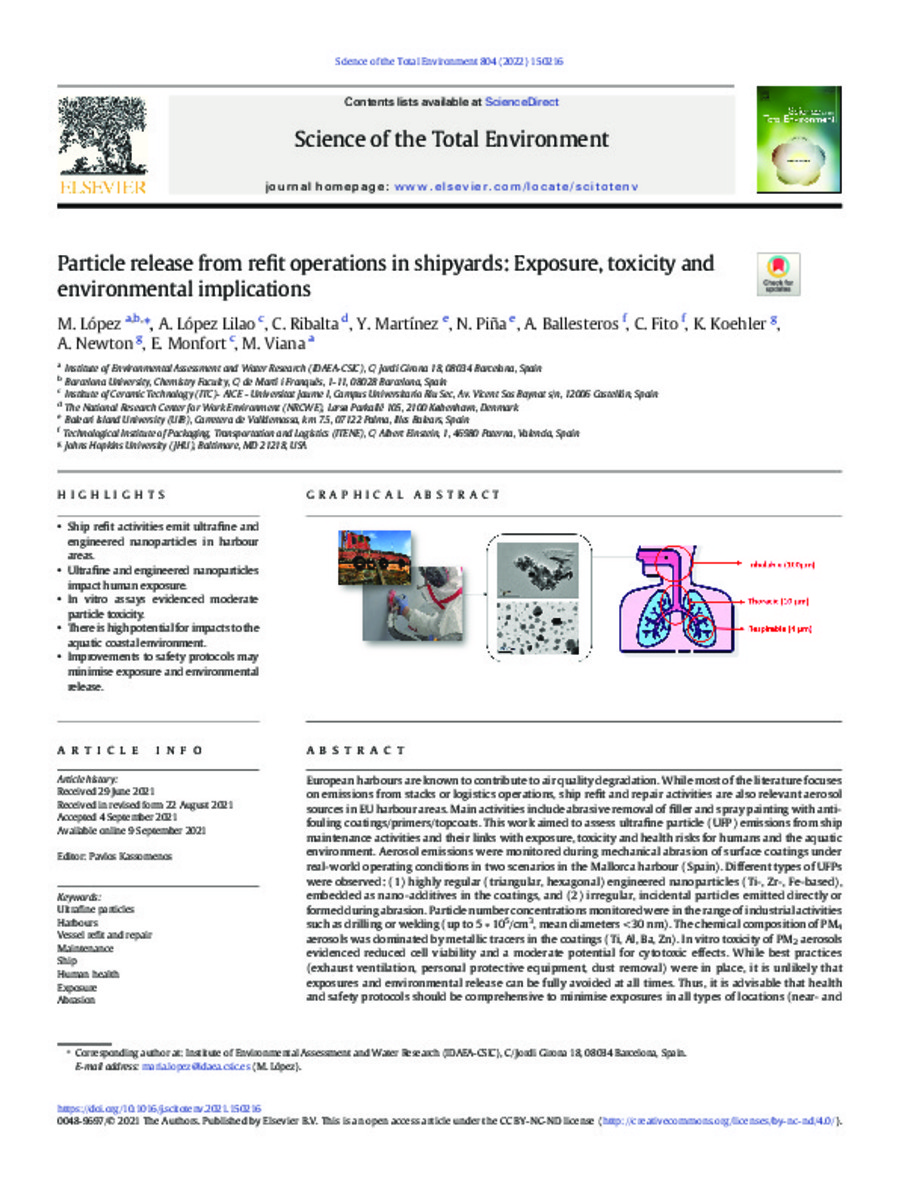Mostrar el registro sencillo del ítem
Particle release fromrefit operations in shipyards: Exposure, toxicity and environmental implications
| dc.contributor.author | López, M. | |
| dc.contributor.author | López Lilao, Ana | |
| dc.contributor.author | Ribalta, C. | |
| dc.contributor.author | Martínez, Y. | |
| dc.contributor.author | Piña, N. | |
| dc.contributor.author | Ballesteros, A. | |
| dc.contributor.author | Fito, C. | |
| dc.contributor.author | Koehler, K. | |
| dc.contributor.author | Newton, A. | |
| dc.contributor.author | Monfort, Eliseo | |
| dc.contributor.author | Viana, Mar | |
| dc.date.accessioned | 2021-10-05T15:52:42Z | |
| dc.date.available | 2021-10-05T15:52:42Z | |
| dc.date.issued | 2021-09-09 | |
| dc.identifier.citation | López M, López Lilao A, Ribalta C, Martínez Y, Piña N, Ballesteros A, Fito C, Koehler K, Newton A, Monfort E, Viana M. Particle release from refit operations in shipyards: Exposure, toxicity and environmental implications. Sci Total Environ. 2021 Sep 9;804:150216. doi: 10.1016/j.scitotenv.2021.150216. Epub ahead of print. PMID: 34520930. | ca_CA |
| dc.identifier.issn | 0048-9697 | |
| dc.identifier.uri | http://hdl.handle.net/10234/194920 | |
| dc.description.abstract | European harbours are known to contribute to air quality degradation.While most of the literature focuses on emissions from stacks or logistics operations, ship refit and repair activities are also relevant aerosol sources in EU harbour areas. Main activities include abrasive removal of filler and spray painting with antifouling coatings/primers/topcoats. This work aimed to assess ultrafine particle (UFP) emissions from ship maintenance activities and their links with exposure, toxicity and health risks for humans and the aquatic environment. Aerosol emissions were monitored during mechanical abrasion of surface coatings under real-world operating conditions in two scenarios in the Mallorca harbour (Spain). Different types of UFPs were observed: (1) highly regular (triangular, hexagonal) engineered nanoparticles (Ti-, Zr-, Fe-based), embedded as nano-additives in the coatings, and (2) irregular, incidental particles emitted directly or formed during abrasion. Particle number concentrationsmonitored were in the range of industrial activities such as drilling or welding (up to 5 ∗ 105/cm3, mean diameters <30 nm). The chemical composition of PM4 aerosols was dominated by metallic tracers in the coatings (Ti, Al, Ba, Zn). In vitro toxicity of PM2 aerosols evidenced reduced cell viability and a moderate potential for cytotoxic effects. While best practices (exhaust ventilation, personal protective equipment, dust removal) were in place, it is unlikely that exposures and environmental release can be fully avoided at all times. Thus, it is advisable that health and safety protocols should be comprehensive to minimise exposures in all types of locations (near- andfar-field) and periods (activity and non-activity). Potential release to coastal surface waters of metallic engineered and incidental nanomaterials, as well as fine and coarse particles (in the case of settled dust), should be assessed and avoided. | ca_CA |
| dc.format.extent | 12 p. | ca_CA |
| dc.format.mimetype | application/pdf | ca_CA |
| dc.language.iso | eng | ca_CA |
| dc.publisher | Elsevier | ca_CA |
| dc.relation.isPartOf | Science of the Total Environment, set. 2021 | ca_CA |
| dc.rights.uri | http://creativecommons.org/licenses/by-nc-nd/4.0/ | ca_CA |
| dc.subject | Ultrafine particles | ca_CA |
| dc.subject | Harbours | ca_CA |
| dc.subject | Vessel refit and repair | ca_CA |
| dc.subject | Maintenance | ca_CA |
| dc.subject | Ship | ca_CA |
| dc.subject | Human health | ca_CA |
| dc.subject | Exposure | ca_CA |
| dc.subject | Abrasion | ca_CA |
| dc.subject | Spray painting | ca_CA |
| dc.subject | Incidental nanoparticles | ca_CA |
| dc.subject | Personal protective equipment | ca_CA |
| dc.title | Particle release fromrefit operations in shipyards: Exposure, toxicity and environmental implications | ca_CA |
| dc.type | info:eu-repo/semantics/article | ca_CA |
| dc.identifier.doi | 10.1016/j.scitotenv.2021.150216 | |
| dc.rights.accessRights | info:eu-repo/semantics/openAccess | ca_CA |
| dc.relation.publisherVersion | https://www.sciencedirect.com/science/article/pii/S0048969721052931 | ca_CA |
| dc.type.version | info:eu-repo/semantics/publishedVersion | ca_CA |
Ficheros en el ítem
Este ítem aparece en la(s) siguiente(s) colección(ones)
-
QUI_Articles [296]








